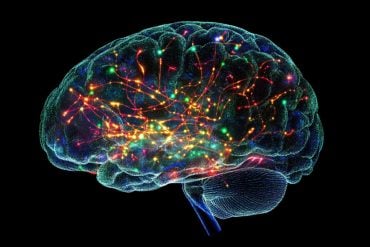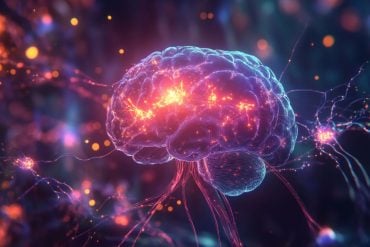Summary: A new study reveals how small world networks can occur within more complex structures.
Source: University of Leicester.
It’s a small world after all — and now science has explained why.
A study conducted by the University of Leicester and KU Leuven, Belgium, examined how small worlds emerge spontaneously in all kinds of networks, including neuronal and social networks, giving rise to the well-known phenomenon of “six degrees of separation.”
Many systems show complex structures, of which a distinctive feature is small-world network organization. They arise in society as well as ecological and protein networks, the networks of the mammalian brain, and even human-built networks such as the Boston subway and the World Wide Web.
The researchers set out to examine whether this is a coincidence that such structures are so wide-spread or is there a common mechanism driving their emergence?
A study recently published in Scientific Reports by an international team of academics from the University of Leicester and KU Leuven showed that these remarkable structures are reached and maintained by the network diffusion, i.e. the traffic flow or information transfer occurring on the network.
The research presents a solution to the long-standing question of why the vast majority of networks around us (WWW, brain, roads, power grid infrastructure) might have a peculiar yet common structure: small-world topology.
The study showed that these structures emerge naturally in systems in which the information flow is accounted for in their evolution.
Nicholas Jarman, who recently completed his PhD degree at the Department of Mathematics, and is first author of the study, said: “Algorithms that lead to small-world networks have been known in scientific community for many decades. The Watts-Strogatz algorithm is a good example. The Watts-Strogatz algorithm, however, was never meant to address the problem of how small-world structure emerges through self-organisation. The algorithm just modifies a network that is already highly organised.”

Professor Cees van Leeuwen, who led the research at KU Leuven said: “The network diffusion steers network evolution towards emergence of complex network structures. The emergence is effectuated through adaptive rewiring: progressive adaptation of structure to use, creating short-cuts where network diffusion is intensive while annihilating underused connections. The product of diffusion and adaptive rewiring is universally a small-world structure. The overall diffusion rate controls the system’s adaptation, biasing local or global connectivity patterns, the latter providing a preferential attachment regime to adaptive rewiring. The resulting small-world structures shift accordingly between decentralised (modular) and centralised ones. At their critical transition, network structure is hierarchical, balancing modularity and centrality — a characteristic feature found in, for instance, the human brain.”
Dr Ivan Tyukin from the University of Leicester added: “The fact that diffusion over network graph plays crucial role in keeping the system at a somewhat homeostatic equilibrium is particularly interesting. Here we were able to show that it is the diffusion process, however small or big gives rise to small-world network configurations that remain in this peculiar state over long intervals of time. At least as long as we were able to monitor the network development and continuous evolution.”
Alexander Gorban, Professor in Applied Mathematics, University of Leicester commented:
“Small-world networks, in which most nodes are not neighbours of one another, but most nodes can be reached from every other node by a small number of steps, were described in mathematics and discovered in nature and human society long ago, in the middle of the previous century. The question, how these networks are developing by nature and society remained not completely solved despite of many efforts applied during last twenty years. The work of N. Jarman with co-authors discovers a new and realistic mechanism of emergence of such networks. The answer to the old question became much clearer! I am glad that the University of Leicester is a part of this exciting research.”
Source: Greta Guest – University of Leicester
Publisher: Content organized by NeuroscienceNews.com.
Image Source: NeuroscienceNews.com image is adapted from the University of Leicester news release.
Original Research: Full open access research for “Self-organisation of small-world networks by adaptive rewiring in response to graph diffusion” by Nicholas Jarman, Erik Steur, Chris Trengove, Ivan Y. Tyukin & Cees van Leeuwen in Scientific Reports. Published online October 13 2017 doi:10.1038/s41598-017-12589-9
[cbtabs][cbtab title=”MLA”]University of Leicester “Six Degrees of Separation: Why It Is a Small World After All.” NeuroscienceNews. NeuroscienceNews, 21 October 2017.
<https://neurosciencenews.com/six-degrees-small-world-7786/>.[/cbtab][cbtab title=”APA”]University of Leicester (2017, October 21). Six Degrees of Separation: Why It Is a Small World After All. NeuroscienceNews. Retrieved October 21, 2017 from https://neurosciencenews.com/six-degrees-small-world-7786/[/cbtab][cbtab title=”Chicago”]University of Leicester “Six Degrees of Separation: Why It Is a Small World After All.” https://neurosciencenews.com/six-degrees-small-world-7786/ (accessed October 21, 2017).[/cbtab][/cbtabs]
Abstract
Self-organisation of small-world networks by adaptive rewiring in response to graph diffusion
Complex networks emerging in natural and human-made systems tend to assume small-world structure. Is there a common mechanism underlying their self-organisation? Our computational simulations show that network diffusion (traffic flow or information transfer) steers network evolution towards emergence of complex network structures. The emergence is effectuated through adaptive rewiring: progressive adaptation of structure to use, creating short-cuts where network diffusion is intensive while annihilating underused connections. With adaptive rewiring as the engine of universal small-worldness, overall diffusion rate tunes the systems’ adaptation, biasing local or global connectivity patterns. Whereas the former leads to modularity, the latter provides a preferential attachment regime. As the latter sets in, the resulting small-world structures undergo a critical shift from modular (decentralised) to centralised ones. At the transition point, network structure is hierarchical, balancing modularity and centrality – a characteristic feature found in, for instance, the human brain.
“Self-organisation of small-world networks by adaptive rewiring in response to graph diffusion” by Nicholas Jarman, Erik Steur, Chris Trengove, Ivan Y. Tyukin & Cees van Leeuwen in Scientific Reports. Published online October 13 2017 doi:10.1038/s41598-017-12589-9






